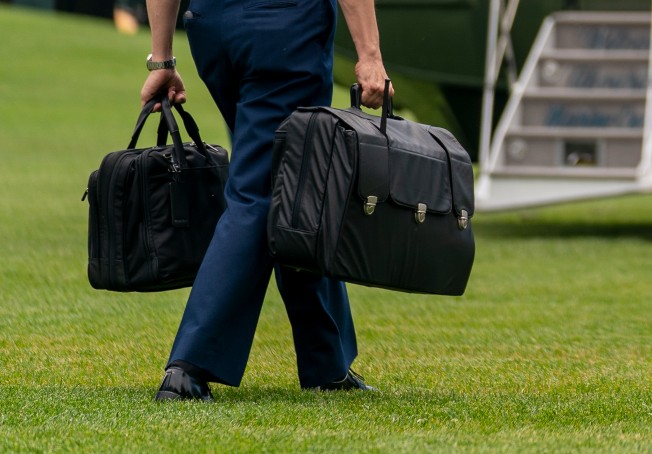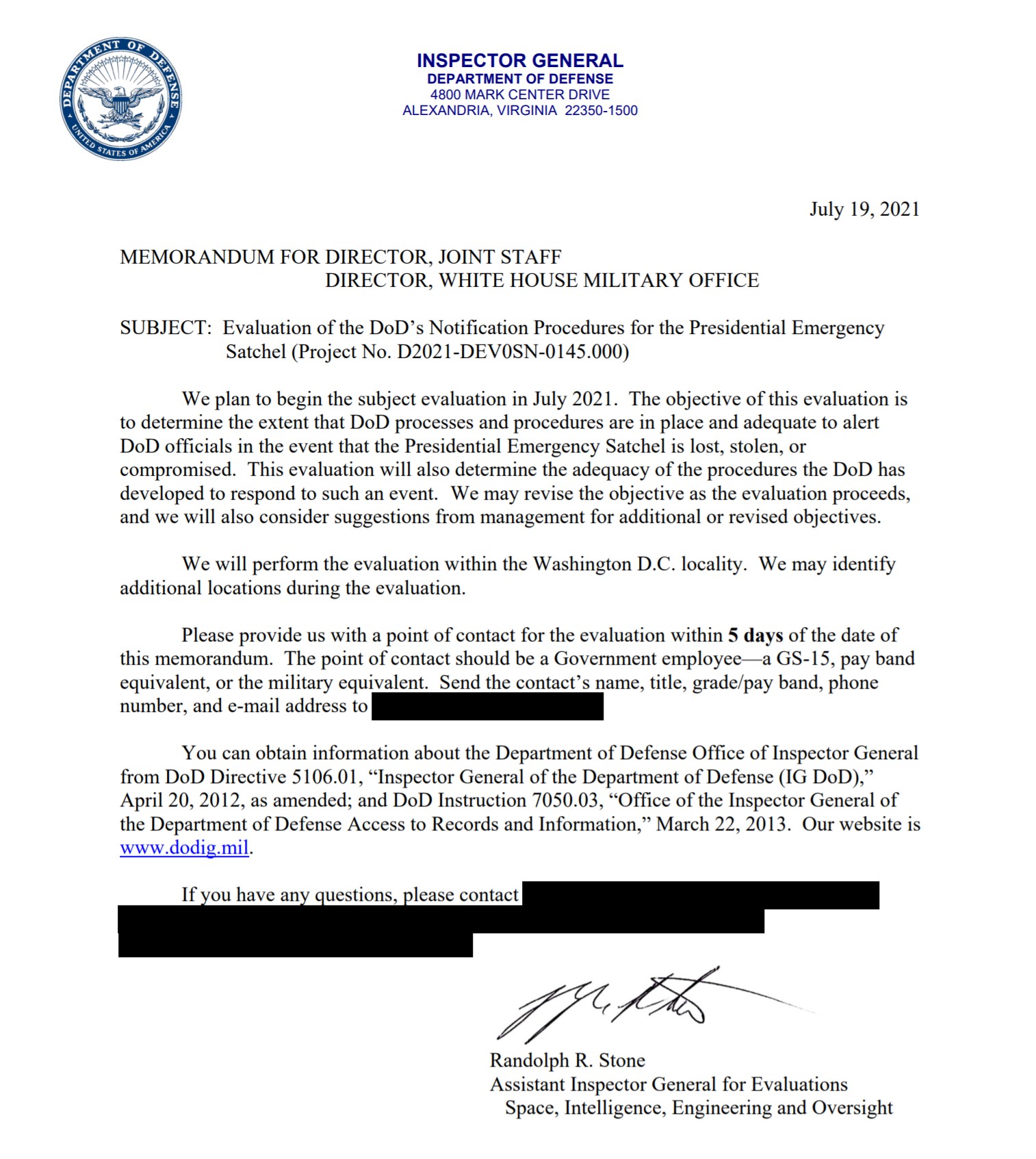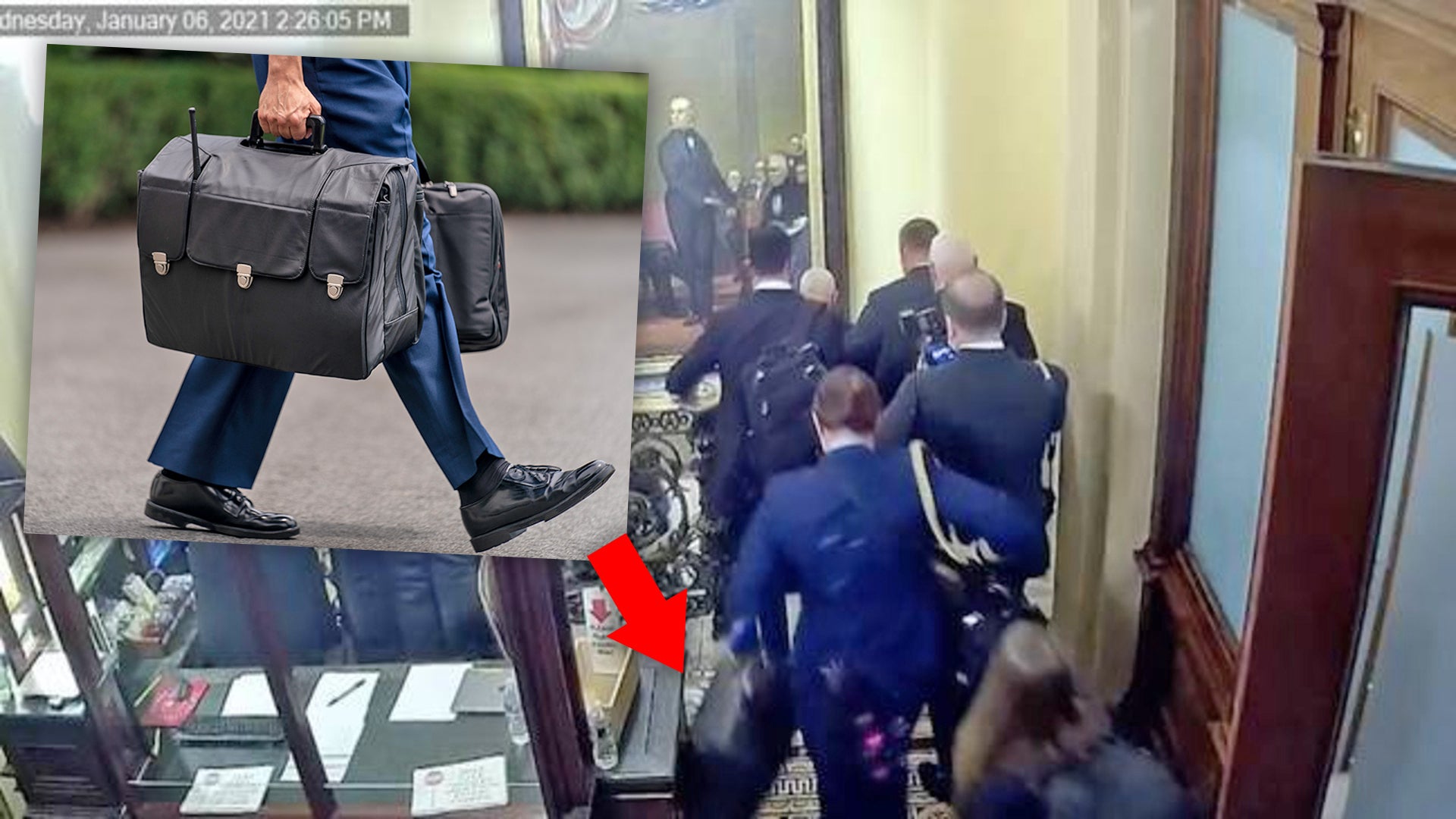The Department of Defense’s (DOD) Office of Inspector General (OIG) has confirmed it will evaluate whether or not there are adequate procedures in place for events that might compromise the safety of the Presidential Emergency Satchel, more commonly known as the “nuclear football.” The review comes in light of the insurrection at the U.S. Capitol on January 6th, 2021 in which protesters were able to storm past Capitol Police and essentially overrun the seat of America’s government.
During the riot at the Capitol, many protesters were heard chanting “Hang Mike Pence.” When protestors breached security and entered the halls of the Capitol, Pence and many members of Congress were rushed to safety through the building’s emergency tunnel network. Security footage was later shown to the U.S. Senate in which Pence and his detail can be seen hurrying down a staircase with the nuclear football in tow. Protesters were reportedly able to reach within 100 feet of the Vice President, who along with the President, is followed 24/7 by a military aide carrying the football.

The contents of the 45-pound Presidential Emergency Satchel aren’t exactly known. According to the Federation of American Scientists, the nuclear football contains a secure telephone, a booklet containing procedures for securing the President in the event of an emergency, a book of codes needed to co-authorize the use of nuclear weapons, and the all-important “black book” of pre-planned targeted response options. Currently, the President has the sole authority to order the use of nuclear weapons by identifying himself to the Pentagon with unique codes that only they possess. These codes are often referred to as the “gold codes” and the President carries them on his or her person in what is called “the biscuit.”
A launch order would be sent to the Pentagon’s National Military Command Center and on to other elements of the National Command Authority (Secretary of Defense) and STRATCOM. If the order is deemed lawful by the Secretary of Defense, which remains a somewhat ambiguous safety mechanism, STRATCOM could launch land-based intercontinental ballistic missiles in as little as two minutes.
The President has a number of military and cabinet advisors who could offer advice in the event that a nuclear strike would be called for, yet just the military aide that carries the football is ready to quickly provide targeting and response option advice to the President alone so that a strike can be quickly ordered with minimal outside support. As noted, no one has the power to override the President, strictly speaking, unless their order is deemed unlawful, especially by the Secretary of Defense. Even then, with such tight timelines involved and the so-called ‘fog of war’ that would surround a sudden and incredibly severe crisis, the effectiveness of this safeguard is debatable. In addition, it is said that elements of the National Command Authority, namely the Secretary of Defense, could be fired until someone in line would execute the order. The entire process remains a hotly debated topic, one that pits the struggle of ensuring a robust nuclear deterrent against the potential for a world-ending mistake or illogical action.
Regardless, none of this can happen if the football is not secure and nearby the President or Vice President at all times. The events of January 6 put this in question.
Randolph R. Stone, the Assistant Inspector General for Evaluations Space, Intelligence, Engineering and Oversight, issued a memo stating that the OIG’s evaluation would begin in July 2021 and would “determine the extent that DoD processes and procedures are in place and adequate to alert DoD officials in the event that the Presidential Emergency Satchel is lost, stolen, or Compromised” and will also “determine the adequacy of the procedures the DoD has developed to respond to such an event.”

Two members of Congress, Rep. Stephen F. Lynch, Chairman of the Committee on Oversight and Reform’s Subcommittee on National Security, and Rep. Jim Cooper, Chairman of the Committee on Armed Services Subcommittee on Strategic Forces, issued a statement following the announcement:
The insurrection at the U.S. Capitol on January 6, 2021, was not only an unprecedented attack on our democracy, but it also put our national security in grave danger. According to public reports, as Vice President Pence hurried away to safety with a military aide carrying his emergency satchel, or ‘nuclear football,’ Pentagon officials were unaware that the football was potentially seconds away from falling into the hands of a lawless mob.
It is imperative that we fully understand the processes and procedures that are in place to protect the Presidential Emergency Satchel—especially when its custodians might be in danger—and we applaud the DOD OIG for accepting our request to initiate this evaluation. We look forward to reviewing their findings once the report is completed.
According to CNN, US Strategic Command was unaware that protestors who stormed the Capitol were able to get so close to Vice President Mike Pence and the backup nuclear football carried by his detail. Since 1992, (USSTRATCOM) has been responsible for all strategic nuclear forces in the United States arsenal.

Kingston Reif, an expert on nuclear weapons policy at the nonpartisan Arms Control Association, told CNN that if protesters had attacked Pence’s detail and gotten their hands on the football, it would have been a “security breach of almost incomprehensible proportions,” allowing information such as pre-planned nuclear strike options to fall into the wrong hands or be shared with the world. The incident “ought to raise further questions about the rationale for the anachronism that is the football,” Reif added.
A letter written in March by Sean O’Donnell, Acting Inspector General for the DOD, also states that USSTRATCOM was “reportedly unaware that Vice President Pence, his military aide, and the nuclear football were all potentially in danger.” O’Donnell states that Strategic Command only came to understand the seriousness of the security breach several weeks after the Capitol insurrection when security camera footage was played during a Senate impeachment trial.
O’Donnell’s letter references another occasion on which the safety of the nuclear football was threatened. In 2017, former White House Chief of Staff John Kelly and a member of the U.S. Secret Service got into a physical altercation with Chinese security forces who blocked the individual carrying the football from following the President. You can read more about the bizarre dust-up in this past article of ours.
“These incidents raise grave national security concerns,” O’Donnell notes. In a separate incident, former President Donald Trump allowed guests at his Mar-A-Lago resort to pose for pictures with the nuclear football, raising questions about who could get close to the satchel.
While the Secret Service Presidential/Vice-Presidential details and counter-assault teams (CAT) could inflict lethal force to protect the football, even with their skill and dedication, an angry mob may not be adequately repelled by such a defense. In this case, things were happening so fast and the space was so crowded, it may not have been possible to put up much of a fight before control of the situation was lost. And it isn’t just about what’s in the case that matters, it is also the symbolic nature of it. It represents the reliability of America’s nuclear deterrent. Losing it would be a major blow to the perception of the deterrent and its ability to be used at a moment’s notice.
Many of these recent incidents have ignited debate over the nuclear football and, more broadly, the powers the United States President has in terms of ordering nuclear strikes. Some have argued that since the threat of nuclear war isn’t as pressing as it was during the Cold War, the President no longer needs to have such executive authority when it comes to ordering nuclear strikes. As others, like General Michael Hayden, the former director of the CIA, have noted, the system “is designed for speed and decisiveness” and “not designed to debate the decision.” Given the speed of intercontinental ballistic missiles, the U.S. would only have minutes to decide to respond to an incoming nuclear strike, making the football still somewhat of a terrifying necessity, at least without major reform to how these weapons are employed and by who.
Contact the author: Brett@TheDrive.com
